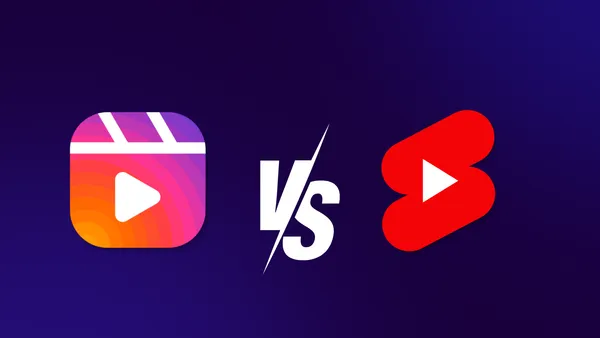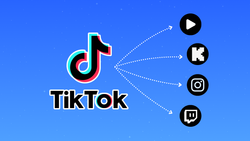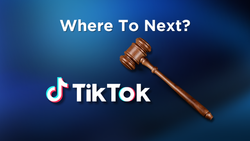On this page
With TikTok's future in limbo, content creators and brands are turning to other short-form video platforms to continue engaging their audiences. Two of the biggest contenders are Instagram Reels and YouTube Shorts. Both platforms offer unique features, but which one is best for you? Let's dive in and compare Instagram Reels and YouTube Shorts to help you decide where to invest your time and creativity.
Instagram Reels
Overview
Instagram Reels is a feature within the Instagram app that allows users to create 15 to 90-second videos. Launched in 2020, Reels has quickly become a popular way for users to discover new content, trends, and creators.
Features
- Editing Tools: Reels offers a variety of editing tools, including music, text overlays, effects, stickers and a multi-clip editor.
- Music Library: Access to a vast library of songs and audio clips, making it easy to add soundtracks to your videos.
- Discovery: Reels are prominently featured in the Explore tab, increasing the chances of your content being discovered by new audiences.
- Integration: Seamlessly integrated with the rest of Instagram, allowing users to share Reels in their feed, Stories, and through direct messages.
Audience
Instagram's user base skews slightly older than TikTok, with a strong presence of Millennials and Gen Z. If your target audience is already active on Instagram, Reels is a natural extension of your content strategy.
YouTube Shorts
Overview
YouTube Shorts is YouTube's answer to the short-form video trend. Shorts were also launched in 2020, and allows creators to upload videos up to 3 minutes long and is designed to be a mobile-first experience with the portrait layout.
Features
- Editing Tools: Shorts provides basic editing features, including the ability to add music, text, and speed controls.
- Music Library: YouTube's extensive music library is available for Shorts, offering a wide range of options for background music.
- Discovery: Shorts appear on the Shorts shelf on the YouTube app and can be discovered through the main YouTube search and recommendations.
- Monetization: YouTube offers various monetization options for Shorts, including ad revenue sharing, which can be attractive for creators looking to earn from their content.
Audience
YouTube's audience is vast and diverse, with users of all ages and interests. Shorts can help you reach a broader audience, especially if your content aligns with popular YouTube niches like gaming, education, or vlogging.
Comparison: Instagram Reels vs YouTube Shorts
1. Reach and Discovery
- Instagram Reels: Benefiting from Instagram's established user base, Reels can help your content reach audiences who are already engaging with similar content on the platform.
- YouTube Shorts: YouTube's search and recommendation algorithms are powerful tools for discovery, potentially offering greater reach, especially for evergreen content.
2. Engagement
- Instagram Reels: High engagement rates due to the platform's interactive features like likes, comments, and shares.
- YouTube Shorts: Engagement can also be high, especially with YouTube's community features like comments and the ability to subscribe to channels.
3. Monetization
- Instagram Reels: Currently, monetization options are limited, focusing mainly on brand partnerships and sponsored content.
- YouTube Shorts: Offers more robust monetization options, including ad revenue sharing, making it more attractive for creators looking to generate income.
4. Content Longevity
- Instagram Reels: Content tends to have a shorter lifespan, with most engagement occurring shortly after posting.
- YouTube Shorts: Videos can continue to be discovered long after they are posted, thanks to YouTube's search and recommendation algorithms.
Which Platform Should You Choose?
Choosing between Instagram Reels and YouTube Shorts depends on your goals and audience. If you're looking to quickly engage with an existing audience and leverage Instagram's features, Reels might be your best bet. However, if you're aiming for long-term growth and monetization, YouTube Shorts offers robust tools to help you succeed.
Ultimately, the best strategy might be to diversify your content across both platforms, maximizing your reach and engagement in the post-TikTok era. Experiment with different content types and see where your audience resonates most.
By understanding the strengths and weaknesses of each platform, you can make an informed decision and continue to thrive in the ever-evolving world of short-form video content.
FAQ
What are Instagram Reels and YouTube Shorts?
Instagram Reels are short, entertaining videos on Instagram that last up to 90 seconds. YouTube Shorts are short-form videos on YouTube, up to 3 minutes long, designed for quick, engaging content.
How do the algorithms of Instagram Reels and YouTube Shorts differ?
Instagram Reels' algorithm focuses on user engagement, such as likes, comments, and shares, and also considers your interaction with similar content. YouTube Shorts' algorithm prioritizes watch time, viewer retention, and the frequency of uploads to decide what to recommend to viewers.
Which platform has a larger user base for short-form content?
Instagram, with its broader user base, attracts more users to Reels, but YouTube’s vast audience and existing content ecosystem give Shorts a significant advantage in reach and discoverability.
Can I monetize my content on both platforms?
Yes, both platforms offer monetization options. Instagram offers monetization through ads and branded content, while YouTube Shorts creators can earn from the YouTube Shorts Fund, channel memberships, and merchandise.
Can I repurpose my TikTok videos on Instagram Reels and YouTube Shorts?
Yes, you can repurpose your TikTok videos for both platforms, but it’s recommended to remove the TikTok watermark to avoid any potential algorithm penalties and ensure the content fits each platform’s guidelines.



